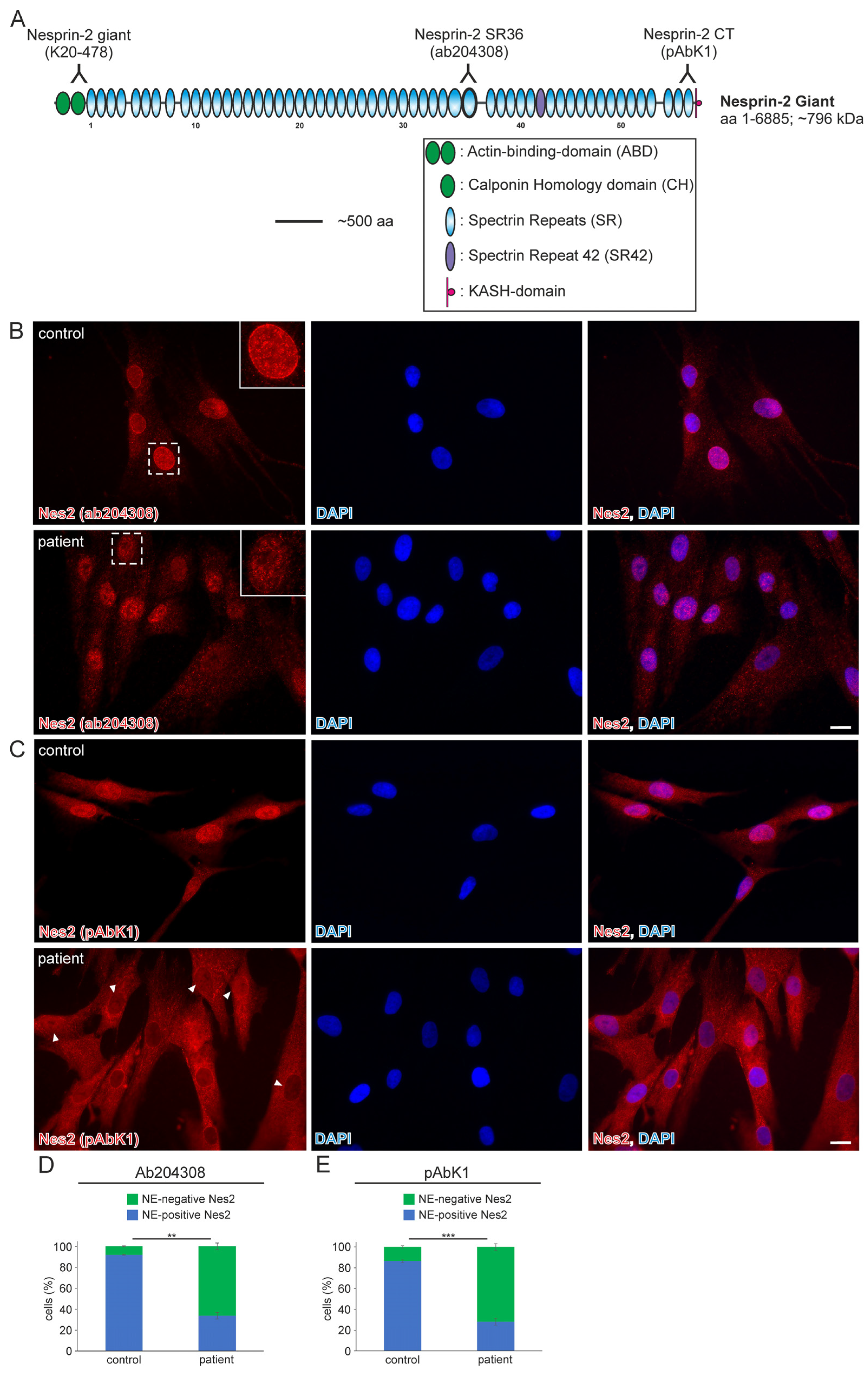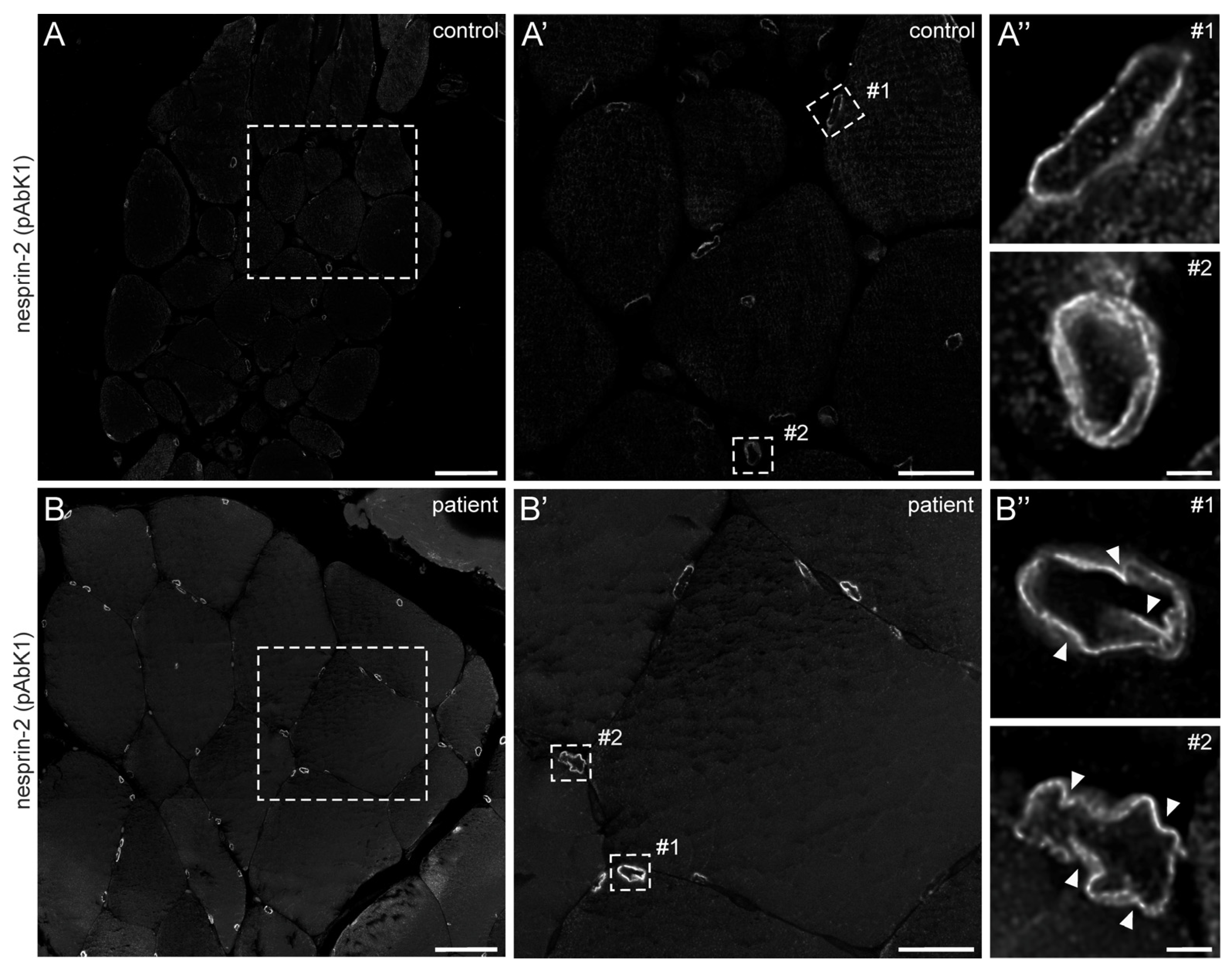An Intronic Heterozygous SYNE2 Splice Site Mutation: A Rare Cause for Myalgia and hyperCKemia?
Abstract
1. Introduction
2. Results
2.1. Adult Patient Case with Myalgia and hyperCKemia
2.1.1. Patient Observations and Family History
2.1.2. Clinical Examination
2.1.3. Genetic Analysis
2.1.4. Muscle Biopsy Findings and Molecular and Cell Biology Examinations
3. Discussion and Conclusions
4. Materials and Methods
4.1. Fibroblast Cultures
4.2. Immunofluorescence (IF) of Cells and Skeletal Muscle Paraffin Sections
4.3. Western Blotting (WB) Analysis
Supplementary Materials
Author Contributions
Funding
Institutional Review Board Statement
Informed Consent Statement
Data Availability Statement
Acknowledgments
Conflicts of Interest
Correction Statement
References
- Zhang, Q.; Minaisah, R.-M.; Ferraro, E.; Li, C.; Porter, L.J.; Zhou, C.; Gao, F.; Zhang, J.; Rajgor, D.; Autore, F.; et al. N-terminal nesprin-2 variants regulate β-catenin signalling. Exp. Cell Res. 2016, 345, 168–179. [Google Scholar] [CrossRef] [PubMed]
- Zhou, C.; Rao, L.; Shanahan, C.M.; Zhang, Q. Nesprin-1/2: Roles in nuclear envelope organisation, myogenesis and muscle disease. Biochem. Soc. Trans. 2018, 46, 311–320. [Google Scholar] [CrossRef] [PubMed]
- Zhang, Q.; Bethmann, C.; Worth, N.F.; Davies, J.D.; Wasner, C.; Feuer, A.; Ragnauth, C.D.; Yi, Q.; Mellad, J.A.; Warren, D.T.; et al. Nesprin-1 and -2 are involved in the pathogenesis of Emery Dreifuss muscular dystrophy and are critical for nuclear envelope integrity. Hum. Mol. Genet. 2007, 16, 2816–2833. [Google Scholar] [CrossRef] [PubMed]
- Rajgor, D.; Shanahan, C.M. Nesprins: From the nuclear envelope and beyond. Expert Rev. Mol. Med. 2013, 15, e5. [Google Scholar] [CrossRef] [PubMed]
- Young, N.; Asif, M.; Jackson, M.; Fernández-Mayoralas, D.M.; de la Peña, M.J.; Calleja-Pérez, B.; Álvarez, S.; Hunter-Featherstone, E.; Noegel, A.A.; Höhne, W.; et al. Biallelic SYNE2 missense mutations leading to nesprin-2 giant hypo-expression are associated with intellectual disability and autism. Genes 2021, 12, 1294. [Google Scholar] [CrossRef] [PubMed]
- Carthew, J.; Karakesisoglou, I. Detection of diverse and high molecular weight nesprin-1 and nesprin-2 isoforms using western blotting. Nucl. Envel. Methods Protoc. 2016, 1411, 221–232. [Google Scholar]
- Rajgor, D.; Mellad, J.A.; Autore, F.; Zhang, Q.; Shanahan, C.M. Multiple novel nesprin-1 and nesprin-2 variants act as versatile tissue-specific intracellular scaffolds. PLoS ONE 2012, 7, e40098. [Google Scholar] [CrossRef] [PubMed]
- King, S.J.; Nowak, K.; Suryavanshi, N.; Holt, I.; Shanahan, C.M.; Ridley, A.J. Nesprin-1 and nesprin-2 regulate endothelial cell shape and migration. Cytoskeleton 2014, 71, 423–434. [Google Scholar] [CrossRef] [PubMed]
- Zhang, Q.; Ragnauth, C.D.; Skepper, J.N.; Worth, N.F.; Warren, D.T.; Roberts, R.G.; Weissberg, P.L.; Ellis, J.A.; Shanahan, C.M. Nesprin-2 is a multi-isomeric protein that binds lamin and emerin at the nuclear envelope and forms a subcellular network in skeletal muscle. J. Cell Sci. 2005, 118, 673–687. [Google Scholar] [CrossRef] [PubMed]
- Kölbel, H.; Abicht, A.; Schwartz, O.; Katona, I.; Paulus, W.; Neuen-Jacob, E.; Weis, J.; Schara, U. Characteristic clinical and ultrastructural findings in nesprinopathies. Eur. J. Paediatr. Neurol. 2019, 23, 254–261. [Google Scholar] [CrossRef] [PubMed]
- Grady, R.M.; Starr, D.A.; Ackerman, G.L.; Sanes, J.R.; Han, M. Syne proteins anchor muscle nuclei at the neuromuscular junction. Proc. Natl. Acad. Sci. USA 2005, 102, 4359–4364. [Google Scholar] [CrossRef] [PubMed]
- Meinke, P.; Schirmer, E.C. The increasing relevance of nuclear envelope myopathies. Curr. Opin. Neurol. 2016, 29, 651–661. [Google Scholar] [CrossRef] [PubMed]
- Janin, A.; Gache, V. Nesprins and Lamins in Health and Diseases of Cardiac and Skeletal Muscles. Front. Physiol. 2018, 9, 1277. [Google Scholar] [CrossRef] [PubMed]
- Pauly, M.G.; Brüggemann, N.; Efthymiou, S.; Grözinger, A.; Diaw, S.H.; Chelban, V.; Turchetti, V.; Vona, B.; Tadic, V.; Houlden, H.; et al. Not to miss: Intronic variants, treatment, and review of the phenotypic spectrum in VPS13D-related disorder. Int. J. Mol. Sci. 2023, 24, 1874. [Google Scholar] [CrossRef] [PubMed]
- Randles, K.N.; le Lam, T.; Sewry, C.A.; Puckelwartz, M.; Furling, D.; Wehnert, M.; McNally, E.M.; Morris, G.E. Nesprins, but not sun proteins, switch isoforms at the nuclear envelope during muscle development. Dev. Dyn. 2010, 239, 998–1009. [Google Scholar] [CrossRef] [PubMed]
- Ketema, M.; Kreft, M.; Secades, P.; Janssen, H.; Sonnenberg, A. Nesprin-3 connects plectin and vimentin to the nuclear envelope of Sertoli cells but is not required for Sertoli cell function in spermatogenesis. Mol. Biol. Cell 2013, 24, 2454–2466. [Google Scholar] [CrossRef] [PubMed]
- Maddox, D.M.; Collin, G.B.; Ikeda, A.; Pratt, C.H.; Ikeda, S.; Johnson, B.A.; Hurd, R.E.; Shopland, L.S.; Naggert, J.K.; Chang, B.; et al. A mutation in Syne2 causes early retinal defects in photoreceptors, secondary neurons, and Müller glia. Investig. Ophthalmol. Vis. Sci. 2015, 56, 3776–3787. [Google Scholar] [CrossRef] [PubMed]
- Hunter-Featherstone, E.; Young, N.; Chamberlain, K.; Cubillas, P.; Hulette, B.; Wei, X.; Tiesman, J.P.; Bascom, C.C.; Benham, A.M.; Goldberg, M.W.; et al. Culturing keratinocytes on biomimetic substrates facilitates improved epidermal assembly in vitro. Cells 2021, 10, 1177. [Google Scholar] [CrossRef] [PubMed]
- Madej-Pilarczyk, A. Clinical aspects of Emery-Dreifuss muscular dystrophy. Nucleus 2018, 9, 268–274. [Google Scholar] [CrossRef] [PubMed]



Disclaimer/Publisher’s Note: The statements, opinions and data contained in all publications are solely those of the individual author(s) and contributor(s) and not of MDPI and/or the editor(s). MDPI and/or the editor(s) disclaim responsibility for any injury to people or property resulting from any ideas, methods, instructions or products referred to in the content. |
© 2024 by the authors. Licensee MDPI, Basel, Switzerland. This article is an open access article distributed under the terms and conditions of the Creative Commons Attribution (CC BY) license (https://creativecommons.org/licenses/by/4.0/).
Share and Cite
Paulus, T.; Young, N.; Jessop, E.; Berwanger, C.; Clemen, C.S.; Schröder, R.; Ploski, R.; Hagel, C.; Hellenbroich, Y.; Moser, A.; et al. An Intronic Heterozygous SYNE2 Splice Site Mutation: A Rare Cause for Myalgia and hyperCKemia? Muscles 2024, 3, 100-109. https://doi.org/10.3390/muscles3010010
Paulus T, Young N, Jessop E, Berwanger C, Clemen CS, Schröder R, Ploski R, Hagel C, Hellenbroich Y, Moser A, et al. An Intronic Heterozygous SYNE2 Splice Site Mutation: A Rare Cause for Myalgia and hyperCKemia? Muscles. 2024; 3(1):100-109. https://doi.org/10.3390/muscles3010010
Chicago/Turabian StylePaulus, Theresa, Natalie Young, Emily Jessop, Carolin Berwanger, Christoph Stephan Clemen, Rolf Schröder, Rafal Ploski, Christian Hagel, Yorck Hellenbroich, Andreas Moser, and et al. 2024. "An Intronic Heterozygous SYNE2 Splice Site Mutation: A Rare Cause for Myalgia and hyperCKemia?" Muscles 3, no. 1: 100-109. https://doi.org/10.3390/muscles3010010
APA StylePaulus, T., Young, N., Jessop, E., Berwanger, C., Clemen, C. S., Schröder, R., Ploski, R., Hagel, C., Hellenbroich, Y., Moser, A., & Karakesisoglou, I. (2024). An Intronic Heterozygous SYNE2 Splice Site Mutation: A Rare Cause for Myalgia and hyperCKemia? Muscles, 3(1), 100-109. https://doi.org/10.3390/muscles3010010






